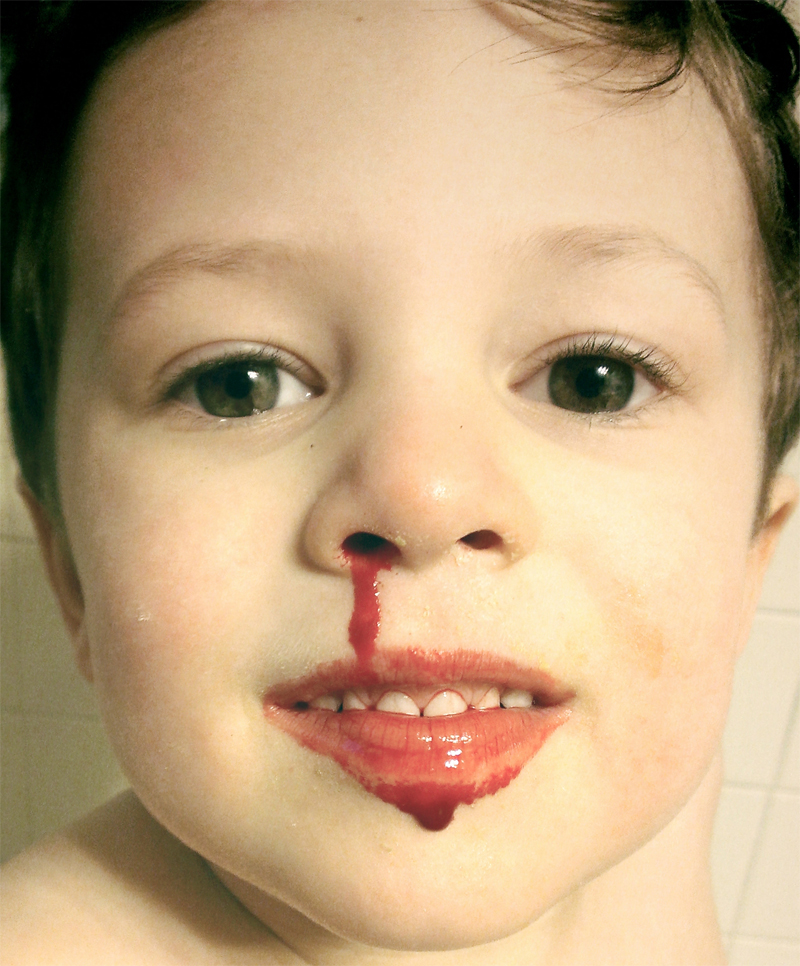 Bleeding from the nose channel by a rupture of blood vessels in the nostril.
Bleeding from the nose channel by a rupture of blood vessels in the nostril.
An incident of bleeding from the nose, usually caused by a blow or by sneezing, by blowing the nose hard or by high blood pressure (informal).
A flow of blood from the nose, a frequent occurrence in children between ages 2 and 10. Also called epistaxis, a nosebleed is commonly due to dryness caused by low humidity in the home, nose picking, inflammation of the nasal lining from a cold or allergies, a foreign object in the nose, blowing the nose too hard, or falling on or hitting the nose. Rarely, abnormal growths or a problem with blood clotting causes nosebleeds. Minor nosebleeds can be treated at home. A person with a nosebleed should sit straight up and tip his or her head forward, so blood will not flow down the throat. The individual should not lie down or tilt his or her head back. The sides of the nose should be pinched together for 5 to 10 minutes, while the person breathes through the mouth. After-, wards, an ice pack can be applied to the nose.
Bleeding from the nose, which may be caused by physical injury or may be associated with fever, high blood pressure, or blood disorders. The blood often comes from a vessel just inside the nostril, in which case the flow may be stopped by applying pressure on the side of the nose. Otherwise gauze packing may be effective in controlling the loss of blood.
Bleeding from the mucous membrane that coats the interior of the nasal passages is known as a nosebleed. This occurrence is frequent among children; however, the bleeding is typically slight and ceases spontaneously. Nosebleeds are equally prevalent among adults, particularly those aged 50 and above, and can sometimes be severe. Within this age demographic, the bleeding might originate from the rear of the nasal passages, proving challenging to halt. Should the blood be ingested, the bleeding might not be externally visible.
Nosebleeds can frequently manifest without any apparent trigger. In settings characterized by low humidity or throughout the winter season, the nasal membranes can become parched and fissured, leading to instances of bleeding. Another potential cause of nosebleeds is damage to the inner lining of the nose due to impacts like a blow to the nose, forceful nose-blowing, or even nose-picking. Among children, nosebleeds are commonly associated with vigorous and rough play.
The presence of a foreign object within the nasal cavity or an infection affecting the upper respiratory tract can also lead to nosebleeds. In individuals aged 50 and above, the delicate blood vessels within the nasal passages might be more brittle, increasing the likelihood of ruptures and subsequent bleeding.
Infrequently, persistent nosebleeds can serve as an indicator of an underlying condition, such as hypertension (elevated blood pressure), a bleeding disorder like thrombocytopenia, or the presence of a nasal or paranasal sinus tumor. Additionally, nosebleeds can be attributed to medications that hinder the normal process of blood clotting.
The overwhelming majority of nosebleeds are brief in duration and do not necessitate targeted intervention. Typically, applying pressure to the pliable portion of the nose (by pressing both sides together) for approximately 15 minutes is sufficient to halt a nosebleed. In cases where the nasal membranes are dry or fissured, using a water-based ointment on the affected area can potentially aid in preventing nosebleeds.
If a nosebleed endures for more than approximately an hour, seeking medical attention is advised. Addressing a severe nosebleed might involve the placement of nasal sponges within the nostrils to absorb blood or the insertion and inflation of a balloon catheter to halt the bleeding. If the origin of the bleeding isn’t apparent, a visual examination of the nasal passages using an instrument may be conducted to identify ruptured blood vessels or potential tumors. Alternatively, imaging methods such as X-rays or MRI scans (which generate cross-sectional or three-dimensional body structure images) could be employed. Subsequent treatment would be based on addressing the underlying cause. In certain cases, surgical intervention might be necessary to ligate and seal leaking blood vessels.
